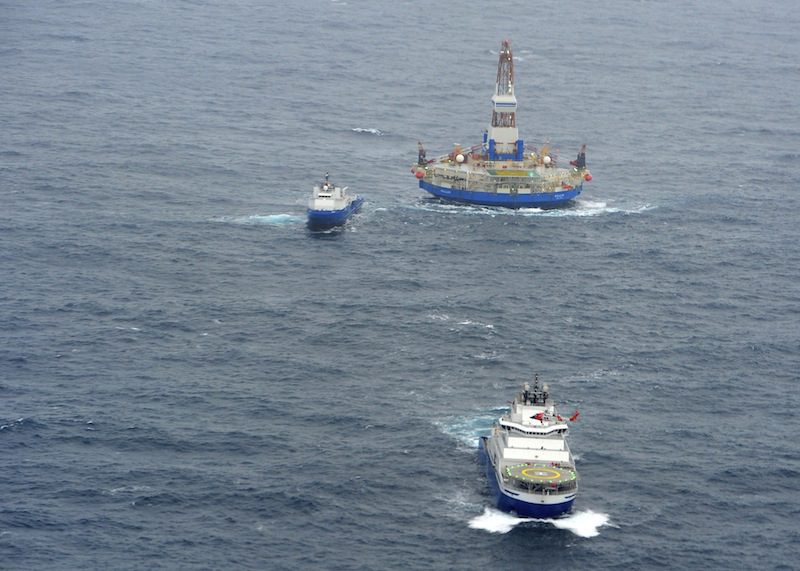Firms in Fed’s Beige Book Fret Over Any Lengthy Baltimore Port Closure
(Bloomberg) — The closure of one of the East Coast’s busiest ports after the collapse of Baltimore’s Francis Scott Key Bridge has so far not led to broad price increases,...


The Kulluk drilling rig under tow by the MV Aiviq (front) 80 miles southwest of Kodiak City, Alaska, on Saturday, December 29, 2012, shortly after the Aiviq began experiencing engine problems. U.S. Coast Guard Photo
By Jim Snyder
Oct. 28 (Bloomberg) — Royal Dutch Shell Plc is asking the Obama administration for five more years to explore for oil off Alaska’s coast, saying set backs and legal delays may push the start of drilling past the 2017 expiration of some leases.
Shell, which has spent eight years and $6 billion to search for oil in the Arctic’s Beaufort and Chukchi seas, said in letter to the Interior Department that “prudent” exploration before leases expire is now “severely challenged.”
“Despite Shell’s best efforts and demonstrated diligence, circumstances beyond Shell’s control have prevented, and are continuing to prevent, Shell from completing even the first exploration well in either area,” Peter Slaiby, vice president of Shell Alaska, wrote to the regional office of the Bureau of Safety and Environmental Enforcement.
Shell’s plans to produce oil in the Arctic were set back in late 2012 by mishaps involving a drilling rig and spill containment system, and the company has been sued by environmental groups seeking to block the Arctic exploration. The Hague-based company halted operations in 2012 to repair equipment and hasn’t resumed its maritime operations off Alaska’s northern coast.
The July 10 letter from the company, released yesterday by the environmental group Oceana that got it after a public records request, seeks to pause Shell’s leases for five years. That would, in effect, extend the deadline to drill on its Beaufort and Chukchi leases.
Leases issued by the government for the right to drill for oil in the Arctic expire in 10 years unless the holder can show significant progress toward development.
Return Considered
Shell has left open the possibility of returning to Arctic drilling as soon as next year. Spokesman Curtis Smith said that timeline remains on the table.
“We’re taking a methodical approach to a potential 2015 program,” Smith said in an e-mail. The U.S. has ordered that any drilling in the Arctic end each year before Oct. 1, when ice starts forming.
The Interior Department “has received Shell’s request, which is currently under consideration,” Nicholas Pardi, spokesman for the department’s Bureau of Safety and Environmental Enforcement, said in a statement yesterday.
The U.S. estimates 23 billion barrels of recoverable oil may lie off Alaska’s northern coast, though environmental groups say drilling in harsh Arctic conditions can’t be done safely. The typical Arctic drilling season is no longer than three or four months.
Rough Seas
While Shell cited events outside its control, its efforts have been beset by its own missteps, including the grounding in rough seas of one of its drilling rigs on the last day of 2012.
The U.S. Coast Guard said in April that a desire to avoid millions of dollars in Alaska state taxes played a role in Shell’s decision to move the rig in rough seas.
A containment dome that would be used in the event of a spill was damaged during testing. Another drill ship, the Noble Discoverer, slipped its moorings in July 2012 and drifted toward shore in Alaska’s Aleutian Islands.
Environmental groups including Washington-based Oceana, which got the July letter through the Freedom of Information Act request, say the mishaps show that the company isn’t prepared to drill in the Arctic.
“Ultimately, Shell has no one to blame but itself,” said Michael LeVine, Pacific senior counsel for Oceana based in Juneau, the Alaska state capital.
‘Not Bend’
The Interior Department temporarily stopped the clock on some of Shell’s leases due to court decisions and other delays. Any further suspension isn’t warranted, he said.
“The government should not bend the rules to accommodate Shell or any other company just because that company spent a lot of money,” LeVine said.
In its letter, Shell said it needed certainty from the U.S. before investing beyond the $6 billion it’s already spent.
It cited court delays, a shortened drilling season, and the lack of “Arctic-viable” drilling rigs as reasons why additional time was needed.
The U.S. is revising its drilling safety regulations for the Arctic. In the July 10 letter, Shell cited the pending rules as another example of the uncertainties it faces.
“In Shell’s circumstances, the totality of all the various delays and unanticipated circumstances has precluded, and likely will further thwart, Shell’s ability to exercise its lease rights” before they expire, the company said in the letter.
Copyright 2014 Bloomberg.
Join the gCaptain Club for curated content, insider opinions, and vibrant community discussions.


Join the 105,953 members that receive our newsletter.
Have a news tip? Let us know.
Access exclusive insights, engage in vibrant discussions, and gain perspectives from our CEO.
Sign Up




Maritime and offshore news trusted by our 105,953 members delivered daily straight to your inbox.



Essential news coupled with the finest maritime content sourced from across the globe.
Sign Up